Core Particle System Nodes#
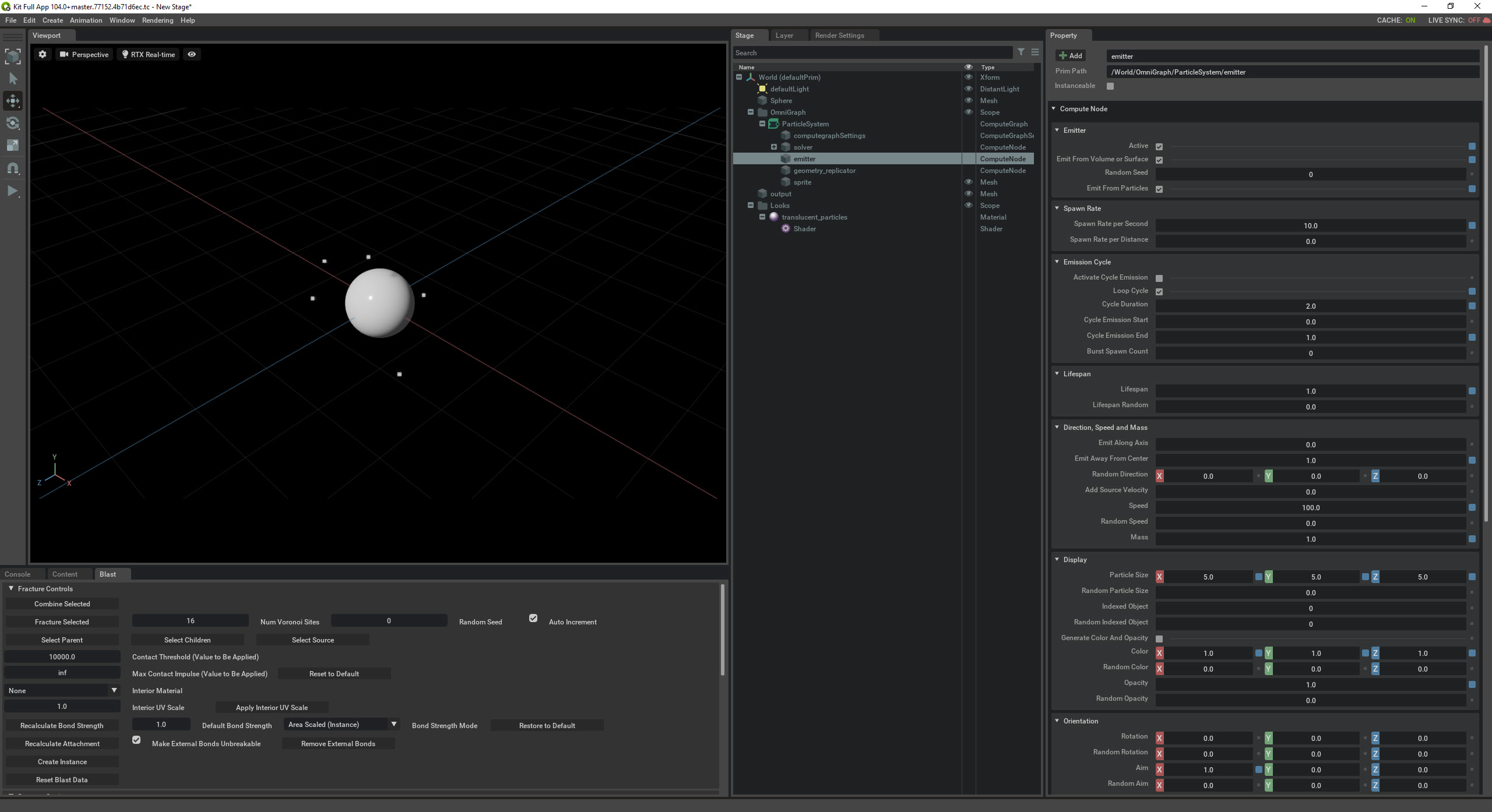
The following are the default nodes when you make a base particle system.
This node holds the collection of core nodes a particle system consists of. A subgraph is a scope that can contain nodes. Each subgraph can be scheduled and evaluated in a different way.
Omnigraph offers push pull and dirty pull evaluation. An action graph evaluator. In the future more evaluations will come online.
A complex effect may be assembled from multiple particle systems.
Emitter Node#
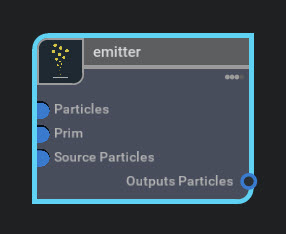
The emitter injects new particles into the system. Its UI is divided into several sections: Emitter, Emission Cycle, Spawn, Display, Orientation, Collision and Source Primitive sections.
Emitter#
This group of parameters control the Emitter basics.
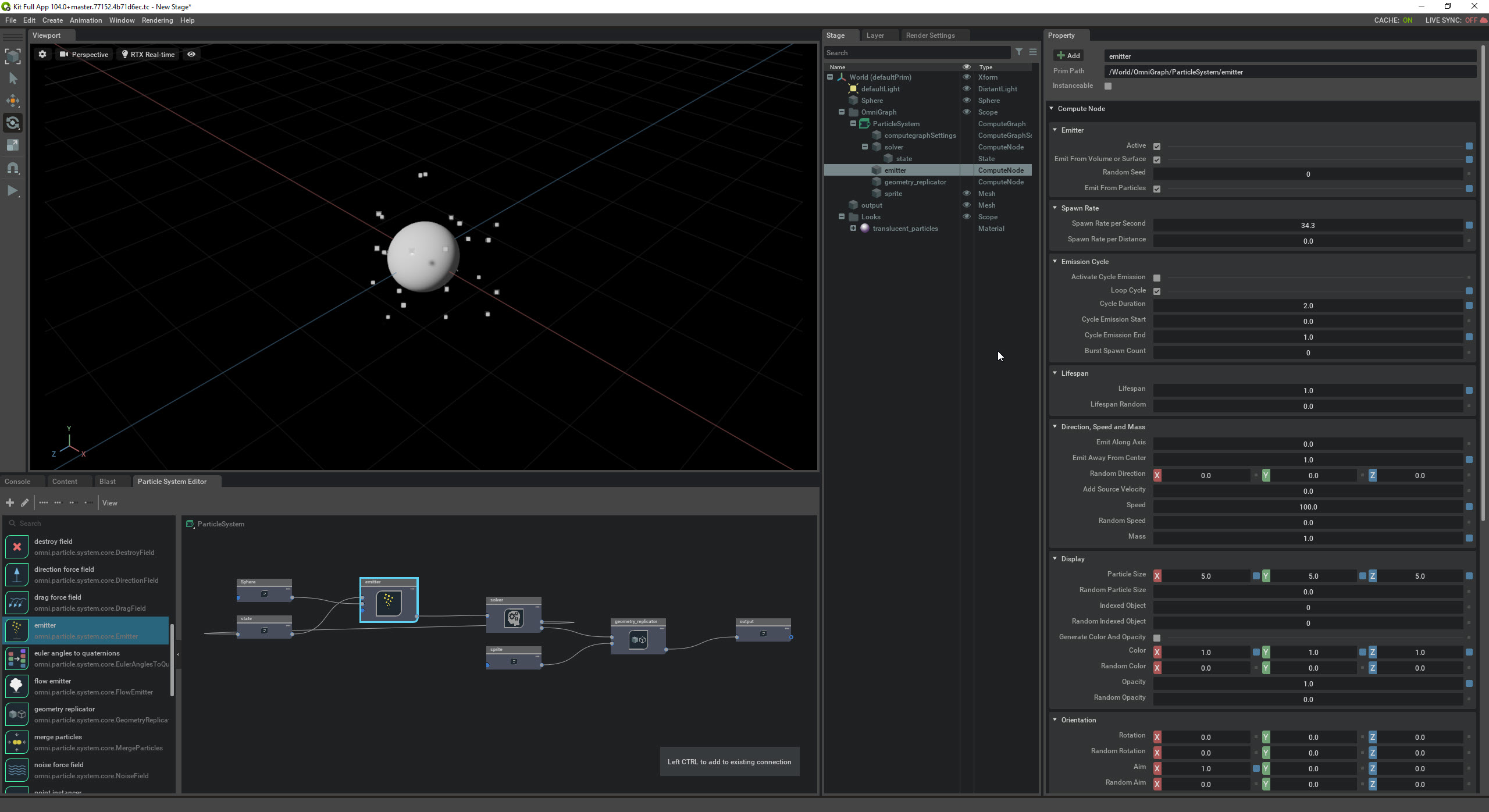
Emitter |
Description |
|---|---|
Active |
Toggle: Controls whether the Emitter Node is Active or Inactive.
|
Emit from Volume or Surface |
Toggle: When enabled, particles will be emitted throughout the volume of the Emitter Source Prim.
When disabled, particles will be emitted from the surface of the Emitter Source Prims.
|
Random Seed |
Changing this value changes the particles emitted randomly.
|
Emit From Particles |
When enables, particles can be emitted from particles.
|
Emitter Spawn Rate#
This group controls how you want the particle to spawn. Burst, looping.

Spawn Rate |
Description |
|---|---|
Spawn Rate Per Second |
Emission rate number of particles per second.
|
Spawn Rate Per distance |
Emission rate, in particles per unit of distance.
Emission active when source moves.
|
Emitter Emission Cycle#
This group of parameters control the Emitter Node’s method of spawning. The particle system is looping or bursting.

Emission Cycle |
Description |
|---|---|
Activate Cycle Emission |
Toggle: When Enabled, emission will be made active and inactive in cycles with period specified by the Cycle Emission.
Enable this toggle to use Burst Spawn Count.
The active portion is specified by Cycle Emission Start and Cycle Emission End.
|
Loop Cycle |
Toggle: When Activate Burst Emission is on and this is enabled, the cycle runs repeatedly.
When Activate Burst Emission is on and this is disabled, the cycle only runs once.
|
Cycle Duration |
When Activate Cycle Emission is on, this is the cycle time period in seconds.
|
Cycle Emission Start |
This is a value from 0 to 1 indicating where in the cycle emission starts.
This only applies when Activate Cycle Emission is on.
If this value is 0, the emission will start at the beginning of the cycle, regardless of cycle duration.
Example: If cycle duration is 7 seconds, and this value is 0.5, emission will start 3.5 seconds after the beginning of each cycle.
Example: If cycle duration is 4 seconds, and this value is 0.5, emission will start 2 seconds after the beginning of each cycle.
|
Cycle Emission End |
This is a value from 0 to 1 indicating where in the cycle emission ends.
This only applies when Activate Cycle Emission is on.
If this value is 1, the emission will stop at the end of the cycle, regardless of cycle duration.
Example: If cycle duration is 7 seconds, and this value is 0.5, emission will end 3.5 seconds after the beginning of each cycle.
Example: If cycle duration is 4 seconds, and this value is 0.5, emission will end 2 seconds after the beginning of each cycle.
|
Burst Spawn Count |
Number of particles to emit at time zero or at the beginning of the Emission in each cycle.
Activate Cycle Emission must be enabled.
|
Emitter Lifespan#
This group allows you to change the lifespan of the particle in seconds.

Lifespan |
Description |
|---|---|
Lifespan |
Lifetime of the particles in seconds
|
Lifespan Random |
Randomly change the lifetime to the particle per spawn.
|
Emitter Direction, Speed and Mass#
This group of parameters control the particle’s behavior on spawn.
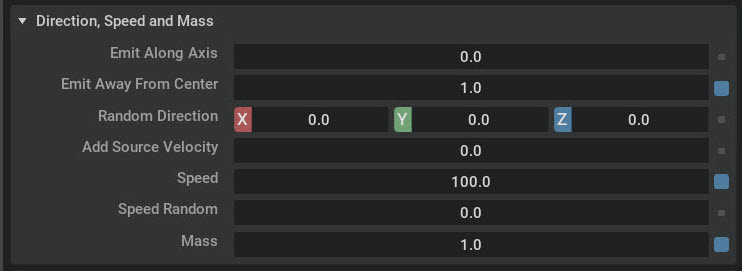
Direction, Speed and Mass |
Description |
|---|---|
Emit Along Axis |
Uses the Emitter Source toi push particles along the X axis.
Rotate the Emitter Source to change the push direction.
Emit Along Axis averages with Emit Away From Center
Speed influences the particle’s speed.
|
Emit Away From Center |
Pushed particles out from the Emitter Source Shape normals.
The shape of the Emitter Source influences the direction of the push.
Emit Away from Center averages with Emit Along Axis.
Speed influences the particle outward push.
|
Random Direction |
Push particles in a random X,Y,Z direction per spawn.
|
Add Source Velocity |
When this is non-zero, this portion of the velocity of an emission source is added to the particles emitted from it.
The higher positive or negative value, the more velocity applied respectively.
If zero no velocity is applied.
|
Speed |
The outward movement of the particle per Spawn
See Emit Along Axis and Emit Away From Center.
|
Speed Random |
Randomly change the Speed of the particle per spawn.
|
Mass |
“Weight” of the particle.
|
Emitter Display#
This group of parameters control the particle’s visualization. This works with the Translucent Material.
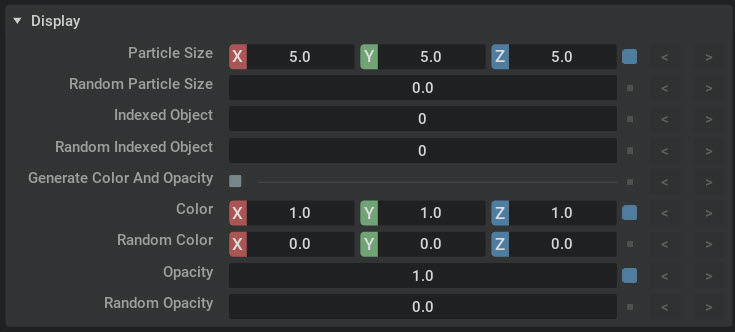
Display |
Description |
|---|---|
Particle Size |
Change the size of the particle or mesh in X,Y,Z.
|
Random Particle Size |
Randomly change the size of the particle or mesh in X,Y,Z per spawn.
|
Indexed Object |
Object index is valid if you have multiple sources to output.
The number corresponds with the order you imported your sources.
|
Random Indexed Object |
Randomly pick an Object Index source in a range per spawn.
|
Generate Color and Opacity |
Toggle: If enabled the particle will generate color and opacity.
This allows the particle to be colored with vertex colors and opacity to be influenced by a float.
|
Color |
Sets a vertex color per particle spawn.
You must have Generate Color and Opacity enabled above and Enable Vertex Colors enabled in your Translucent Material
|
Random Color |
Sets a random vertex color to the particle per spawn.
You must have Generate Color and Opacity enabled above and Enable Vertex Colors enabled in your Translucent Material.
|
Opacity |
Controls how transparent your particle renders.
You must have Generate Color and Opacity enabled above and Enable Opacity enabled in your Translucent Material
If your translucent Particle isn’t displaying correctly, toggle Enable Fractional Cutout Opacity in RTX Settings, Ray Tracing.
|
Random Opacity |
Randomly change the particle Opacity per particle spawn.
You must have Generate Color and Opacity enabled above and Enable Opacity enabled in your Translucent Material
If your translucent Particle isn’t displaying correctly, toggle Enable Fractional Cutout Opacity in RTX Settings, Ray Tracing.
|
Emitter Orientation#
This group of parameters control the particle’s orientation.
Controlling Orientation If you want a particle or shape to be in a specific orientation, disable Face Active Camera and Orient With Active Camera in the Geometry Replicator or Point Instancer. Aim Inherits Velocity in Solver also can influence Orientation.

Orientation |
Description |
|---|---|
Rotation |
Rotate the particle in X Y Z in degrees.
|
Random Rotation |
Randomly rotate the particle in X, Y, Z along a degree range per spawn.
|
Aim |
Aim points the particle in a specific direction in x,y,z.
|
Random Aim |
Aim the particle in a random direction per spawn.
|
Up |
Change the ‘top’ value of the particle in x, Y, Z.
|
Random Up |
Randomly change the ‘top’ value of the particle on spawn.
|
Emitter Emit From Particles#
This group allows you to alter the trail of the emitter. You must have the particles as a source for your trail emissions for these parameters to function. This group allows you to inherit the following parameters from the particle system source emitter.
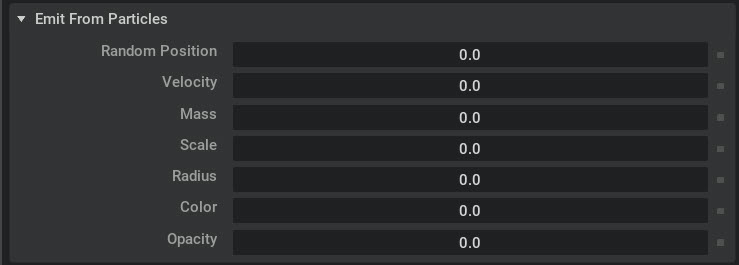
Emit From Particles |
Description |
|---|---|
Random Position |
Multiplier: Randomize source particle positions.
|
Velocity |
Multiplier: Inherit Velocity when emitting from particles.
|
Mass |
Multiplier: Inherit Mass when emitting from particles.
|
Scale |
Multiplier: Inherit Scale when emitting from particles.
|
Radius |
Multiplier: Inherit Radius when emitting from particles.
|
Color |
Multiplier: Inherit Color when emitting from particles.
|
Opacity |
Multiplier: Inherit Opacity when emitting from particles.
|
Emitter Collision#
This group of parameters control the particle’s collision shape.

Collision |
Description |
|---|---|
Radius Influences Scale |
Toggle: If enabled the Radius of the collision multiplies the Size of the particle.
You must have Scale Inherit Collision Radius toggled in the Solver.
|
Collision Radius |
The radius of the particle collision in the world.
|
Self Collision Radius |
The radius of the particle collision with other particles.
|
Random Radius |
Randomly set a collision radius in a range.
|
Emitter Source Primitive#
This group allows you to add source primitives to your emitter.

Source Primitive |
Description |
|---|---|
Primitive |
This field shows where your source geometry primitive is located in the stage/layer.
|
Add Target(s) |
This button allows you to add source primitives to the emitter.
|
Solver Node#
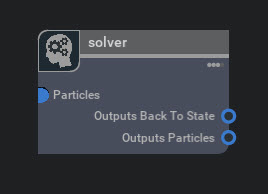
The solver node implements numerical integration of the underlying particles data at each simulation step.
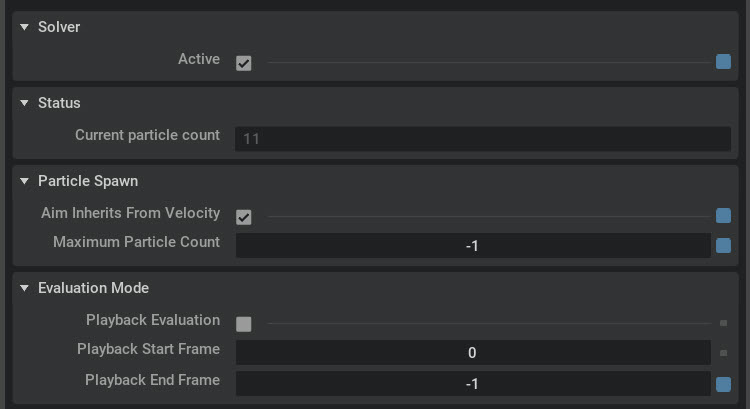
Solver#
Solver Parameter |
Description |
|---|---|
Active |
Toggle: Controls whether the Node is Active or Inactive.
|
Solver Status#
Status Parameter |
Description |
|---|---|
Current Particle Count |
Displays the active count of particles in real time
|
Solver Particle Spawn#
Particle Spawn Parameter |
Description |
|---|---|
Aim Inherits Velocity |
Aim parameters inherit the velocity of the particle.
|
Maximum Particle Count |
The Maximum amount of particles to spawn per cycle.
-1 is no maximum.
|
Solver Evaluation Mode#
Evaluation Mode Parameter |
Description |
|---|---|
Playback Evaluation |
Toggle: Simulate in runtime or animation playback mode.
|
Playback Start Frame |
The start frame of the simulation in animation playback mode.
|
Playback End Frame |
The end frame of the simulation in animation playback mode.
-1 is no end frame.
|
State prim#

The State prim is automatically created by the Solver when a particle system is createdusing the menu method. It has no user-facing functionality.
Euler Angles to Quaternions Node#
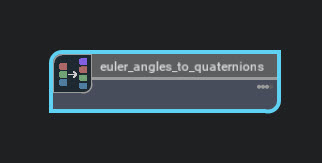
This node converts rotations from Euler angles to quaternions.

Euler Angles to Quaternions#
Euler Angles to Quaternion Parameter |
Description |
|---|---|
Rotation order |
the order of rotation
|
Merge Particle Node#
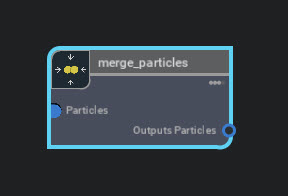
The Merge Particles node combines multiple particle systems.
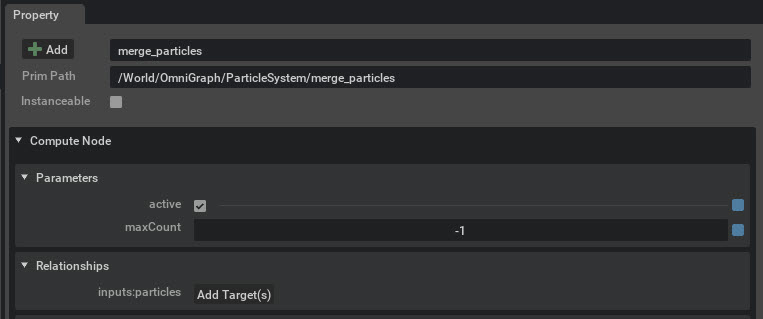
Merge Particles#
Merge Particles Parameter |
Description |
|---|---|
Active |
Toggle: Is the Merge Particles Node active?
|
Max Count |
What is the maximum count of particles to spawn per cycle
-1 means to spawn particles based on spawn rate
|
Merge Particles Relationships#
Merge Particles Relationships |
Description |
|---|---|
inputs:particles |
Add Targets: Allows you to add particle relationships
|
Simulation Space Node#
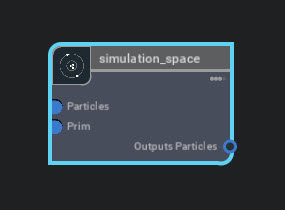
The Simulation Space Node allows you to attach a particle to the local space of an object. The particle system is locked into that object’s position, rotation, and scale.

Simulation Space#
Simulation Space |
Description |
|---|---|
Active |
Toggle: Is the Simulation Space Node active?
|
Simulation Space Use#
Use |
Description |
|---|---|
Position |
Toggle: Is the position currently active?
|
Rotation |
Toggle: Is the rotation currently active?
|
Scale |
Toggle: Is the scale currently active?
|